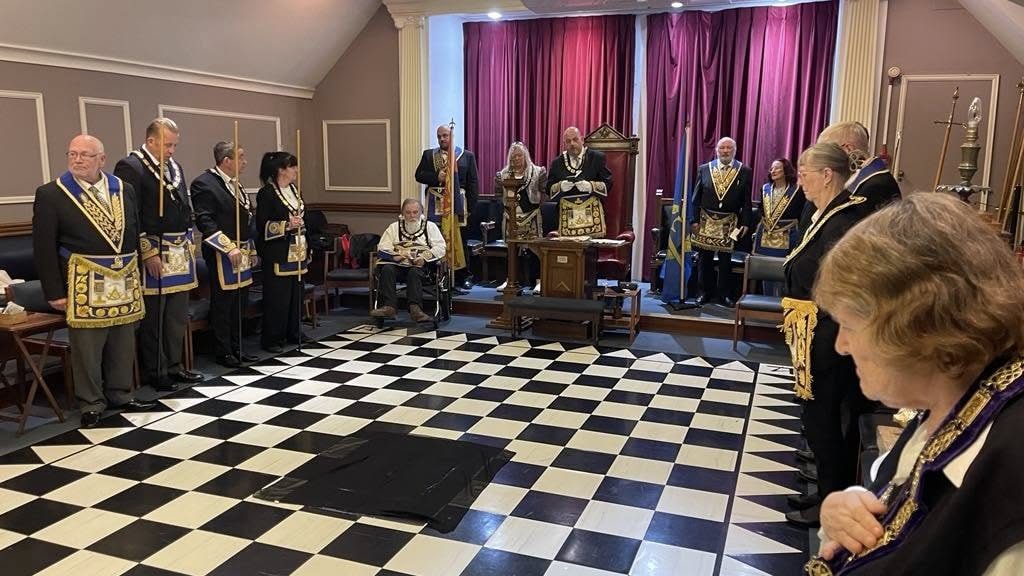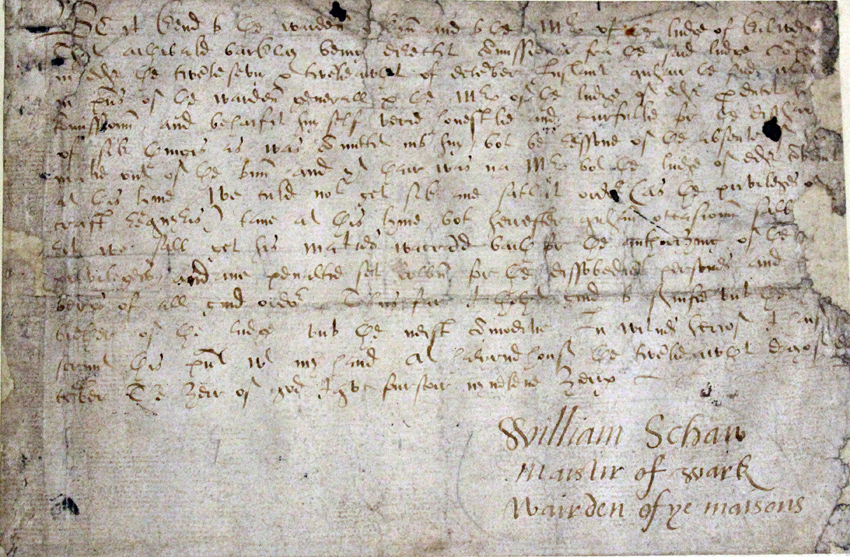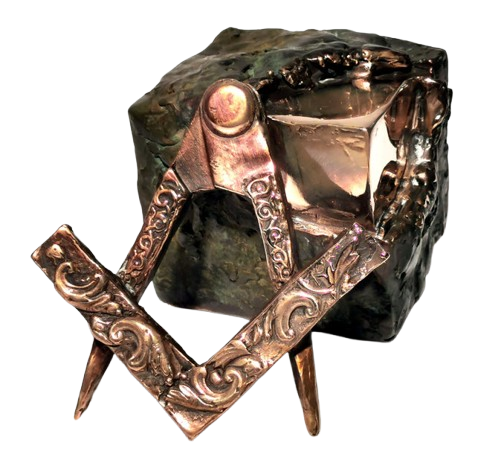Dear Brethren, dear Guests,
A Masonic lodge is a place of contemplation, of seeking, and of symbolism.
Symbols and rituals are, for us, the central tools on the path to self-knowledge, humanity, and indeed, spirituality.

Freemasonry is not a secret society, but rather a society with secrets – and these secrets are not hidden facts, but deeper insights that each person must discover for themselves. Our rituals and symbols assist in this process. They are not empty forms, but living mirrors of our thoughts and feelings. Find out more below.
Our rituals took shape primarily during the Age of Enlightenment, a tradition we continue to honour.
1. What is a Symbol?
A symbol is more than a mere sign. It points to something that cannot be fully captured in words. A symbol speaks to our intellect – but also to our soul. Freemasonry employs a wide variety of such symbols: the square, the compasses, the plumb line, the rough and the pefect ashlar, and many more. They originate in the medieval stonemasons’ craft, which serves as an external framework – yet their inner meaning is timeless.
When we speak of shaping the rough ashlar, we do not mean rock, but ourselves. Our character – our being in the world – is what we seek to refine. Not with hammer and chisel in a literal sense, but with mindfulness, integrity, and humanity.
The interpretation of symbols is left to each Freemason. In this way, we avoid dogmatic teachings. All these symbols appear in our rituals.
2. Why Rituals?
A ritual is a meaningful act. It lifts a moment out of the everyday and gives it depth and direction. In a world that often feels loud, fast, and superficial, the ritual creates a space for reflection. It is a journey inward.
Our rituals – often expressed in symbolic language – speak of the human journey: from darkness to light, from the unformed to the formed, from the individual to the community, and ultimately of transience – perhaps because death makes all equal. I believe that only truly altruistic deeds endure: what we do for others, not for ourselves.
Rituals speak to us on many levels: emotionally, intellectually, and spiritually.
Those who experience a Masonic ritual for the first time often feel a strange mix of unfamiliarity and recognition. For although everything may seem different from the world outside – it resonates deeply within us, as though echoing something primordial.

3. The Effect
Even though they initiate, symbols and rituals do not transform people overnight. They offer impulses. They create an atmosphere in which self-reflection becomes possible – where we meet as equals, and where values such as tolerance, humanity, and truth are not merely spoken of, but genuinely felt and actively lived.
In our work as Freemasons, we do not strive for perfection – but for improvement. Not for dogma – but for understanding. Not for separation – but for connection. It may seem paradoxical: yet it is precisely the privacy and secrecy of our lodges that serve this purpose.
4. Another Thought
Goethe, himself a Freemason, wrote in his Faust:
“What you have inherited from your fathers, earn it and practice it, to make it your own.”1
(I would, today, of course, include the mothers.)
And he was right: Our symbols and rituals are a legacy. They come alive only when they work through us – when we fill them anew with meaning, in our thinking, our feeling, and our actions. Even in everyday life.
5. An Example
I know many of us wear Masonic symbols – for instance, on their ring fingers. They serve as reminders of our vows to humanity. They provide ideas and orientation, day in and day out. Some, I know, place symbols on their desks – as I do too.
Perhaps the most well-known Masonic symbols are these:

A rough ashlar being worked. The square. The compasses. This is a bronze sculpture by my dear friend and Brother, Jens Rusch.
The compasses – perhaps a symbol of universal love, radiating equally in all directions from a central point. Or a symbol of the spiritual and the immaterial – perhaps even of eternity, for the number pi has no final digit, no end in this world.
The square, on the other hand, with its precise 90°, might symbolise the physical world, but certainly also justice and the application of law.
And then a rough ashlar, already partly shaped and perfected. What a powerful image! The social psychologist Erich Fromm might call it a universal symbol – one that everyone can relate to: a symbol of being on the way, of change, of effort and growth.2
The early Freemasons of the 17th and 18th centuries saw in it the building blocks of Solomon’s Temple, the temple erected in honour of the Great Architect of the Universe by the wisest of kings, Solomon. A fun fact: Solomon’s Temple (if it existed at all) was reportedly built using unhewn stones.3 Yet the early Freemasons explicitly viewed themselves as such stones or ashlars – to be shaped and fitted into the Temple – in a Christian, mildly deistic perspective, enriched with Jewish mythology. Today, it’s often viewed more secular: the lodges work symbolically on the great Temple of Humanity. And every stone and ashlar adds beauty and progress to this vast construction.
What might the symbols in the bronze mean together – the compasses, the square, the ashlar? We do not prescribe interpretations. But, of course, these symbols appear in our rituals, often with emphasis on liberty, equality, and fraternity.
We keep our rituals and ceremonies secret – to foster trust among us, and to preserve the direct, unspoiled experience for future candidates. Expectations spoil impact. I therefore urge you to avoid reading Masonic rituals, easily found in any good library, if you are genuinely considering joining.
Our rituals contain nothing that would in any way contradict human dignity. That, I can assure you.
6. Craft and High Degrees
The idea of growth and being on the way is also expressed through our degrees. They combine wonder and learning, labour and reflection, understanding and refinement.
The degrees are themselves symbols – guides – and should never be mistaken for actual hierarchies.
The first three degrees – Entered Apprentice, Fellowcraft, and Master Mason – trace the path of life and form a complete system. In nearly every part of the world, the Masonic journey begins and ends with these three so-called Craft Degrees – named after Saint John the Baptist, the patron of the old building lodges. Occasionally, there is an intermediate degree – the Mark Master Mason – in which each Freemason receives their own stonemason’s mark, echoing the medieval practice of signing one’s work: for me, a symbol of individuality, independence, and creative responsibility.
We are often asked about the so-called higher or additional degrees, which pop culture loves to mystify. Indeed, one may continue the Masonic path beyond the Master degree, though we are all forever apprentices. When I learned that I had been admitted to the 33rd and final degree of the so-called Scottish Rite – one of these additional systems – I chose the plumb line as the topic for my festive lecture. It is, in fact, an apprentice symbol – a symbol of self-knowledge and unity – but I wanted to show that everything essential is actually already contained in the very first degree. There is no privilege, no higher or better rank. All degrees are just perspectives. And in this great psychodrama, we each remain the central figure.
We have many Lodges and Chapters dedicated to such further degrees. They build upon the Craft Degrees and Craft Lodges, introducing additional symbols that often reach beyond the symbolism of building lodge masonry.
You might encounter a mother pelican feeding her chicks with her own blood – a profound symbol of sacrifice and love. Or legends surrounding Jacques de Molay, the last Grand Master of the Templars, who was wrongly condemned to death, alongside cries of “Down with tyranny!” Well, the forebears were certainly creative. But I shall reveal no more. After all, you are only just setting out – as a seeker, perhaps on the path to becoming an Entered Apprentice.
7. Practice
What all Masonic traditions have in common is the work on the self and the service to humanity – with many colorful, different accents.
It’s important to understand: it is not the number of degrees that makes a Freemason, but their willingness to undertake inner work, and their resolve to do good in the world. We are all responsible for the inner light we bear – and which we wish to bring into the world. Freemasonry can help us to seek that light more consciously, and to cultivate it among our Brethren.
Dear Guests, I hope that this little introduction has offered you a first impression: that Freemasonry is not about appearances, nor merely about lectures or discussion – but about inner life. Our symbols and rituals are both an invitation and a challenge: to know oneself better, and to become a kind, conscious, and honest human being among other human beings.
Thank you for your attention.
RWBro. Robert Matthees
(Hamburg, 12th of June, 2025)
Footnotes:
- Goethe, J. W.: Faust. Part I, “Night: Faust alone”.
- Cf. Fromm, E.: The forgotten language, 1951 – on the nature of symbolic language.
- According to Altar Law in Judaism; cf. Zwickel, W.: Der salomonische Tempel, 1999, p. 64/65.
Join us now
Just get in touch and we will dicuss the next steps.